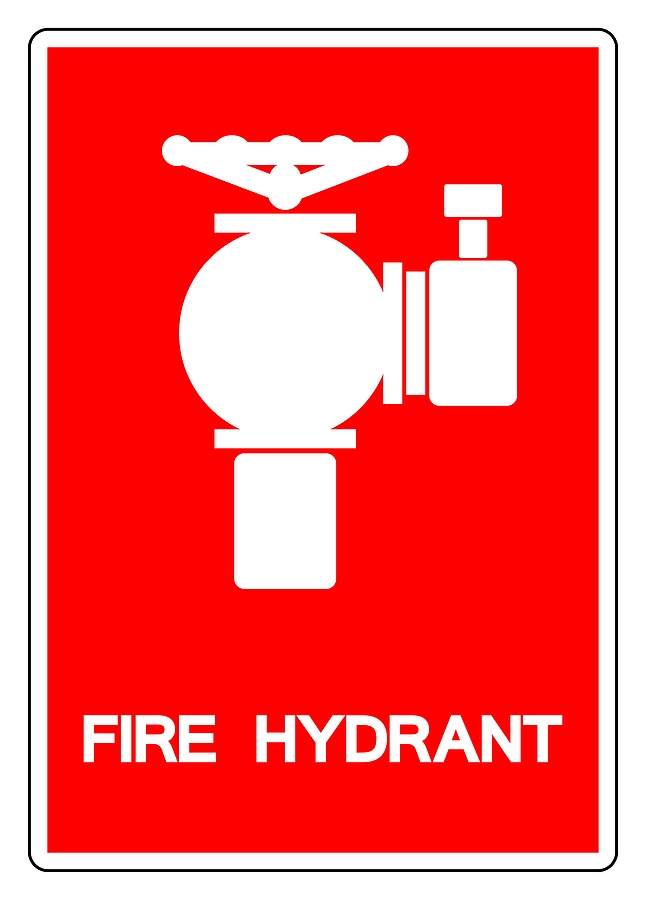Fire engines can only hold so much water yet there is a continuous supply of water underground, like in our shower or sink.
Fire hydrants give firefighters access to this water through their valves which pump water from underground to wherever the water is needed.
You probably see fire hydrants and fire hydrant signs in Melbourne indicating them all the time but didn’t realise that the two are related.
To design fire signs correctly, instead of using the NFPA standard – which is North American and used by other countries – Australia follows the Australian Standard 1319 for all fire-related signs.
Building fire hydrant systems
Some multi-story buildings are so high or large that a fire hydrant on the pavement at the base of the building would be too far away to reach a fire in some spaces of the building.
If this is the case, there are fire hydrants located within the building which often have layflat hose connected to them.
It’s also extremely inconvenient to attach a hose to a hydrant outside a multi-story building and then bring it into the foyer and then up multiple flights of stairs, wrapping it into a long coil.
The further you go up the stairs, the more potential there is for kinks or holes in the hose. That’s why layflat hoses are designed to withstand damage so people can step on them.
A separate plumbing system is installed throughout the building which connects valves to the water source through pipes.
What kinds of fire signs do you need in a building?
Most Australian fire signs are characterised by their bright red colour with clear white text.
They contain minimal words and are often accompanied by a pictogram in order to quickly and clearly convey a message or direct a user to the fire safety equipment.
These signs are normally mounted at eye-level and designed in capital letters so that people can see them immediately.
Is your workplace or residence fire-ready?
Some of the most common fire and safety signs required in a commercial or publicly accessed building, like an office block, factory, or apartment unit include:
Fire Alarm signs
Non-automatic fire alarms can be deliberately turned on in the event of an emergency.
These alarms are quickly identified by signage on the unit itself, to easily help people find them. Large, white block letters on a red background are characteristic of fire safety signs.

Fire Hydrant signs
Fire hydrant signs within a building are located above or on the cupboard that the hydrants are kept in.
A lot of the time, they are kept in the stairwell of buildings or in the foyer. Fire hydrant signs convey messaging simply and easily, with large, white text on a red background.
Fire Extinguisher signs
Often accompanied by a white pictogram of a standard extinguisher, these signs indicate the location of a fire extinguisher. They are usually located adjacent to the device.
Additional signage may include specific operating instructions (though these are also found on the extinguisher itself).
Fire Door signs
Fire Door signs can indicate not only where a fire door is located, but may also communicate additional instructions, such as “DO NOT BLOCK”, “DO NOT OBSTRUCT” or “DO NOT OPEN”.
Fire Door signs quickly alert people to safe or alternative exits in the event of a fire.
Fire Hose signs
Fire hydrant and hose reels signs signs are both indicated on or above the cupboard they are kept inside of. THese signs can be text only or can be accompanied by a pictogram of a long hose.
Sprinkler Booster Valve signs
Sprinkler boosters are generally accompanied by a fire hydrant.
The booster helps the hydrant get access to more water so there can be greater pressure. The signs help firefighters identify if a hydrant has a booster or not. These signs are usually plain text, without a pictogram.
As you can see, fire and fire safety related signage is characterised by white text on a red background. The colour red is universally recognised to denote danger, and is also bright and eye-catching, making these important signs easy to spot.
To ensure your property is compliant when it comes to fire safety, all fire fighting equipment must be easily identified and accessible. These simple signs play their role in helping you find critical equipment.
Other types of fire hydrants
Besides hydrants and other fire-fighting systems in place in commercial or residential buildings, there are two other types of hydrants you might have in mind: above and below ground hydrants.
Above ground hydrants
Above ground fire hydrants are accompanied by a raised blue reflective marker (usually placed on the road). This is to help fire engines and firefighters to easily spot the location of a hydrant.
The three types of above ground fire hydrants are:
1. L type hydrants
- Most common fire hydrants in Victoria
- They are shaped like a rectangular prism with diagonal edge
- The valves are found under the red cap which can be lifted up
2. Pillar hydrants
- Pillar hydrants are cylindrical or tube shaped
- They have valves on the outside for easy access
- Second most common hydrant in Victoria
3. Millcock hydrants
- T-shaped and is less common in Australia
- It is a requirement for millcock hydrants to have its red top painted to cover at least 375mm² of surface area
Below ground hydrants
Underground ground hydrants are the most common form of fire hydrant. They can be located almost anywhere and are unobtrusive when unopened.
If a hydrant is on a road, then the hydrant flap will be painted bright white. There will also be other indications near it, such as “NO Parking” signs.
Need fire service and safety signs for your property?
Signsmart can help you follow the Australian standard for all fire related signs. This helps to prevent accidents and can help you avoid legal trouble if caught not using signs correctly.
We can help with fire extinguisher signs, fire door signs and any other fire related signs.
Order online now, or if you need something custom, get in touch with us today. Call (03) 9687 3050 or contact us online here.







